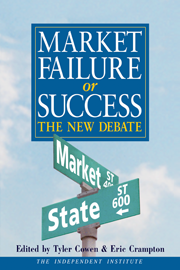What is really behind the mushrooming rate of mortgage foreclosures since 2007? The evidence from a huge national database containing millions of individual loans strongly suggests that the single most important factor is whether the homeowner has negative equity in a house—that is, the balance of the mortgage is greater than the value of the house. This means that most government policies being discussed to remedy woes in the housing market are misdirected.
Many policy makers and ordinary people blame the rise of foreclosures squarely on subprime mortgage lenders who presumably misled borrowers into taking out complex loans at low initial interest rates. Those hapless individuals were then supposedly unable to make the higher monthly payments when their mortgage rates reset upwards.
But the focus on subprimes ignores the widely available industry facts (reported by the Mortgage Bankers Association) that 51 percent of all foreclosed homes had prime loans, not subprime, and that the foreclosure rate for prime loans grew by 488 percent compared to a growth rate of 200 percent for subprime foreclosures. (These percentages are based on the period since the steep ascent in foreclosures began—the third quarter of 2006—during which more than 4.3 million homes went into foreclosure.)
Sharing the blame in the popular imagination are other loans where lenders were largely at fault—such as “liar loans,” where lenders never attempted to validate a borrower’s income or assets.
This common narrative also appears to be wrong, a conclusion that is based on my analysis of loan-level data from McDash Analytics, a component of Lender Processing Services Inc. It is the largest loan-level data source available, covering more than 30 million mortgages.
The McDash data allowed me to construct a housing price index at the zip code level and then calculate the current equity position of each homeowner. I was thus able to compare the importance of negative equity to other variables related to foreclosures.
The analysis indicates that, by far, the most important factor related to foreclosures is the extent to which the homeowner now has or ever had positive equity in a home. The accompanying figure shows how important negative equity or a low Loan-To-Value ratio is in explaining foreclosures (homes in foreclosure during December of 2008 generally entered foreclosure in the second half of 2008). A simple statistic can help make the point: although only 12 percent of homes had negative equity, they comprised 47 percent of all foreclosures.
Further, because it is difficult to account for second mortgages in this data, my measurement of negative equity and its impact on foreclosures is probably too low, making my estimates conservative.
What about upward resets in mortgage interest rates? I found that interest rate resets did not measurably increase foreclosures until the reset was greater than four percentage points. Only 8 percent of foreclosures had an interest rate increase of that much. Thus the overall impact of upward interest rate resets is much smaller than the impact from equity.
To be sure, many other variables—such as FICO scores (a measure of creditworthiness), income levels, unemployment rates and whether the house was purchased for speculation—are related to foreclosures. But liar loans and loans with initial teaser rates had virtually no impact on foreclosures, in spite of the dubious nature of these financial instruments.
Instead, the important factor is whether or not the homeowner currently has or ever had an important financial stake in the house. Yet merely because an individual has a home with negative equity does not imply that he or she cannot make mortgage payments so much as it implies that the borrower is more willing to walk away from the loan.
The difference in policy implications is enormous: A significant reduction in foreclosures will happen when and only when housing prices stop falling and unemployment stops rising.
Although the government is throwing money—almost $2 trillion and counting—at the mortgage markets with the intent of stabilizing house prices, its methods are poorly targeted. While Federal Reserve actions have succeeded in reducing mortgage interest rates, low interest rates induce refinancings more than they do home purchases.
To be sure, refinancings may put money in peoples’ pockets, but it is home purchases that directly impact house prices. Nevertheless, housing prices are likely to stop falling fairly soon with or without government policies. That’s because current prices are approaching their long-term, inflation-adjusted pre-bubble level. These pre-bubble prices appeared to be a long-term equilibrium, meaning that prices would be expected to return to those levels once the government’s efforts to artificially increase homeownership receded. Unfortunately, recent attempts by politicians such as Barney Frank (D., Mass.) to again artificially increase homeownership levels might delay this return to sustainable equilibrium prices.
Other government policies are likely to be even less effective in reducing foreclosures. The Obama administration’s “Making Homes Affordable” plan focuses on having the government help lower obligation ratios (the share of income devoted to house payments) down to 31 percent from levels somewhat above 38 percent. But my analysis finds that mortgages having such obligation ratios at closing did not later experience high foreclosure rates. This suggests that reducing these ratios is not likely to significantly improve the foreclosure problem.
Understanding the causes of the foreclosure explosion is required if we wish to avoid a replay of recent painful events. The suggestions being put forward by the administration and most media outlets—more stringent regulation of subprime lenders—would not have prevented the mortgage meltdown regardless of their merit otherwise.
Rather, stronger underwriting standards are needed—especially a requirement for relatively high down payments. If substantial down payments had been required, the housing price bubble would certainly have been smaller, if it occurred at all, and the incidence of negative equity would have been much smaller even as home prices fell. A further beneficial regulation would be a strengthening, or at least clarifying at a national level, of the recourse that mortgage lenders have if a borrower defaults. Many defaults could be mitigated if homeowners with financial resources know they can’t just walk away.
We are at a crossroads where we can undo the damage to the housing market by strengthening underwriting standards in a reasonable way. But to do so political leaders must face up to the actual causes of the mortgage crisis, not fictitious causes that fit political agendas and election strategies.










